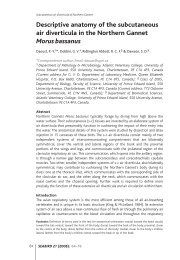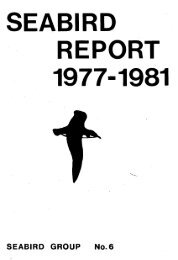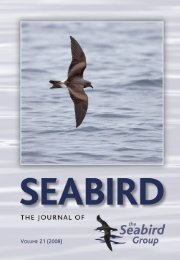You also want an ePaper? Increase the reach of your titles
YUMPU automatically turns print PDFs into web optimized ePapers that Google loves.
2001 Body mass reduction in Kittiwakes 169<br />
RESULTS<br />
<strong>The</strong> body masses of female Black-legged Kittiwakes recorded in the field two<br />
weeks prior to hatching and around hatching time did not differ significantly (on<br />
average 387 ± 24 g, n = 33), nor did the body mass values obtained early and<br />
later on in the chick-rearing period (on average 342 ± 16 g, n = 31). However,<br />
the latter mean is significantly lower (about 12%) than the incubation period<br />
mean value (t-test, t = 8.663, df = 62, P < 0.001). <strong>The</strong> body masses of the<br />
female Black-legged Kittiwakes recorded in the laboratory at the same time as<br />
the BMR values were recorded (hereafter called the lab body masses) are lower<br />
than the body masses recorded earlier in the field due to the intervening fasting<br />
period. <strong>The</strong>re was no significant difference in relative body mass decrease<br />
between the five groups (Kruskal- Wallis one way ANOVA on ranks, H = 6.87,<br />
P = 0.076) and the reduction was on average 9.1 ± 3.2% (n = 64, we failed to<br />
obtain field body masses for three individuals.).<br />
<strong>The</strong> mean lab body masses for the females two weeks prior to hatching,<br />
around hatching, two weeks into the chick rearing period and late in the chick<br />
rearing period were 347 ± 20 g (n = 24), 360 ± 24 g (n = 10), 312 ± 20 g (n =<br />
17), 313 ± 11 g (n = 7) and 312 ± 13 g (n = 9) respectively (Fig. 1). <strong>The</strong> two<br />
body mass means obtained during the incubation period were not significantly<br />
different from each other, nor were the three body mass means obtained during<br />
the chick-rearing period. However, the mean values obtained during the<br />
incubation period were significantly different from the three mean values for the<br />
chick-rearing period (one-way ANOVA followed by a Student-Newmann-Keul<br />
procedure for pairwise comparisons, F4,62, P < 0.0001). This suggests that body<br />
mass declined from incubation to the chick-rearing period.<br />
<strong>The</strong> ambient temperatures recorded during the BMR measurement<br />
periods ranged from 7 – 24 °C. <strong>The</strong>re was no significant relationship between Ta<br />
and the metabolic rates measured either in the incubation period or in the chickrearing<br />
period. Thus we considered all the measurements to lie within the<br />
thermoneutral zone for Black-legged Kittiwakes on Svalbard, which has<br />
previously been found to include temperatures from 5°C up to at least 20°C<br />
(Gabrielsen et al. 1988).<br />
<strong>The</strong> time from capture in the field to the actual BMR measurement<br />
ranged from 5-24 hours. <strong>The</strong> minimum time of 5 hours may seem insufficient<br />
for the birds to become post-absorptive since 5 hours is the approximate<br />
retention time of Black-legged Kittiwakes (Hilton et al. 1998). However, the<br />
time from capture to the end of the experiment was never less than 10 hours.<br />
<strong>The</strong> minimum metabolic rate recorded as little as 5 hours after capture may<br />
indicate that the birds had already been fasting before capture. In addition,<br />
Hawkins et al. (1997) showed that in Brünnich’s Guillemots the effect of heat








